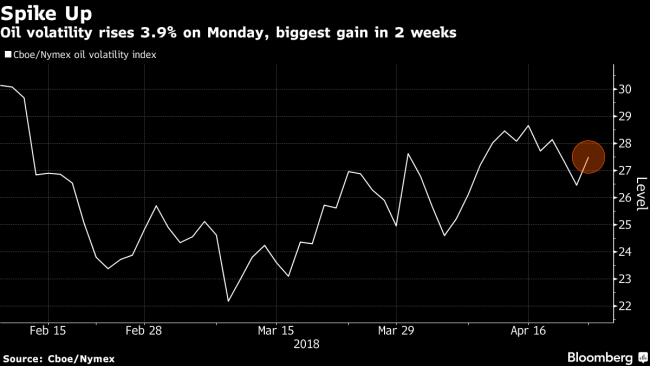
(Bloomberg) — Flaring geopolitical tensions in the Middle East coupled with expectations for a decline in U.S. stockpiles are boosting oil to trade near $69 a barrel.
Futures in New York climbed as much as 0.7 percent. Prices closed at the highest level since December 2014 on Monday while a measure of oil volatility rose the most in two weeks as the conflict between Saudi Arabia and Iran-backed Houthis in Yemen worsened, raising concerns over supply disruptions in the energy-rich Mideast region. Expectations for a drop in inventories added to the gains, with analysts forecasting a second weekly decline.
Oil has rallied this month as the Organization of Petroleum Exporting Countries and its allies concluded that they have all but wiped out a global crude surplus, and Iran signaled the group can end cuts if prices rise more. Still, with production in the U.S. continuing to reach record levels, investors are wary that expanding output from shale producers could thwart OPEC’s efforts to reduce a global glut.
“The market is buying the bullish news at the moment,” Will Yun, a commodities analyst at Hyundai Futures Corp., said by phone. “But the volatility is high, meaning the direction of the market can change at anytime.”
West Texas Intermediate crude for June delivery rose as much as 45 cents to $69.09 a barrel on the New York Mercantile Exchange, and traded at $68.91 at 12:21 p.m. in Singapore. Total volume traded was about 29 percent below the 100-day average.
for June delivery added 18 cents, or 0.2 percent, to $74.89 a barrel on the London-based ICE Futures Europe exchange after climbing 0.9 percent on Monday. The global benchmark crude traded at a $5.98 premium to June WTI after closing at $6.07 on Monday, the highest premium in more than three months.
Volatility Surges
Yuan-denominated futures traded 1.9 percent higher on the Shanghai International Energy Exchange on Tuesday. The contract closed 0.7 percent up at 439.7 yuan per barrel on Monday.
The Cboe/Nymex oil volatility index jumped 3.9 percent on Monday, posting its biggest gain since April 10. Saudi Arabia intercepted ballistic missiles fired by Iran-backed Houthis in Yemen, while a kingdom-led coalition killed a senior leader of the rebel group.
For U.S. crude stockpiles, a Bloomberg survey showed that analysts expect nationwide inventories to have fallen 2.25 million barrels last week. Stockpiles in the nation’s oil storage hub Cushing, Oklahoma, are likely to have fallen 150,000 barrels in the same period, a separate survey showed.
As well as Mideast tensions and U.S. stockpiles, America’s recent softening stance against China and Russia is also boosting sentiment among oil investors, Hyundai Futures’ Yun said. Treasury Secretary Steven Mnuchin is considering lifting sanctions against Russian metal giant United Co. Rusal.
Other oil-market news:
- The Bloomberg Dollar Spot Index was little changed after rising to highest in more than three months on Monday.
- Saudi Aramco, the world’s biggest oil exporter, plans to trade as much as 6 million barrels a day, a jump in volume that would put it in the top tier of companies that buy and sell crude and refined products.
- Exxon Mobil Corp (NYSE:)., which has been a cornerstone of fund managers’ portfolios alongside the biggest names in corporate America, has fallen to ninth-largest company on the S&P 500 Index after leading the measure a decade ago.
Fusion Media or anyone involved with Fusion Media will not accept any liability for loss or damage as a result of reliance on the information including data, quotes, charts and buy/sell signals contained within this website. Please be fully informed regarding the risks and costs associated with trading the financial markets, it is one of the riskiest investment forms possible.
Source: Investing.com




























